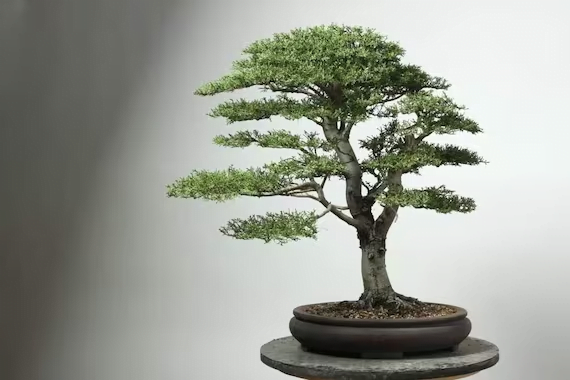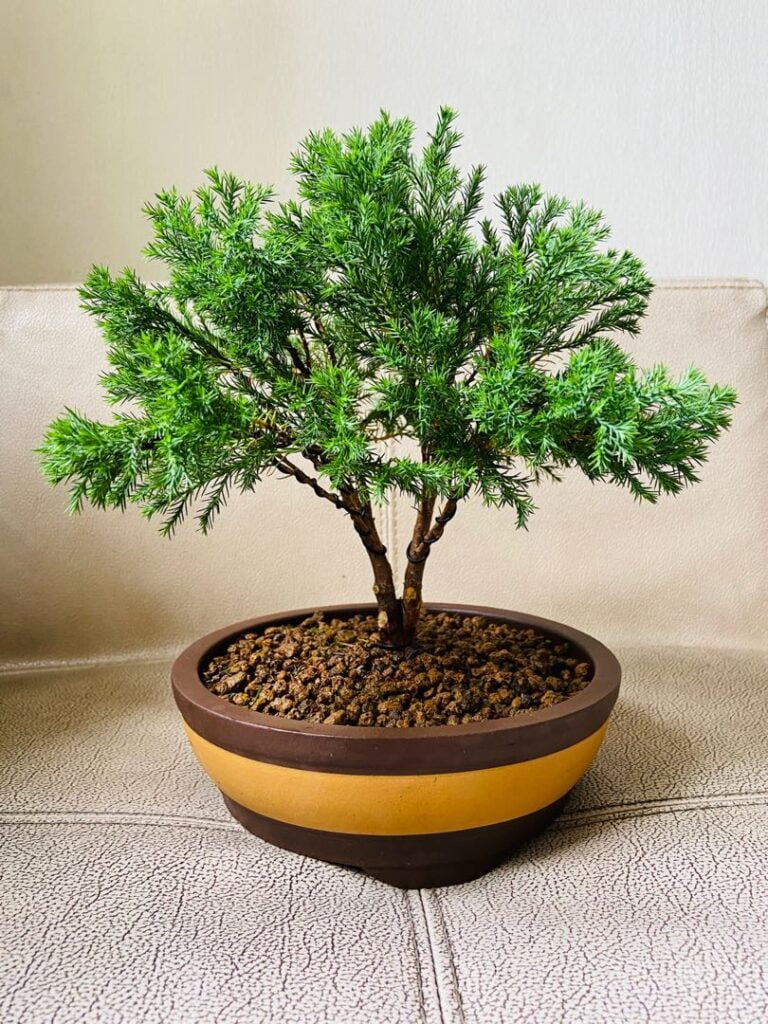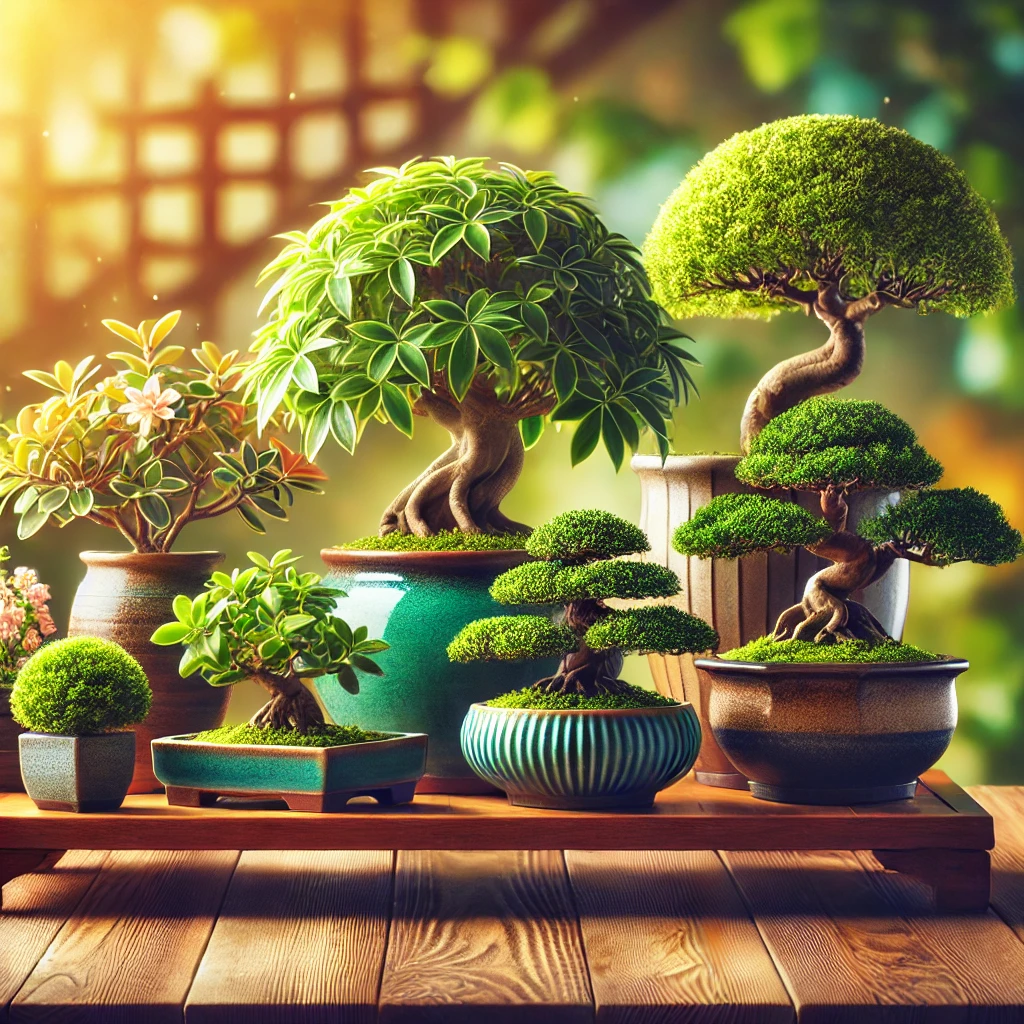Ciprés Monterrey and Cupressus macrocarpa are also names of Monterey cypress. Mainly, people cultivate this bonsai for ornamental values. This dramatic cone-shaped tree is great for decorations.
No matter where you place it, it adds charms, and with proper care, it will flourish in its healthiest form. So, let’s see what are the requirements for this wonderful plant.
Monterey Cypress Bonsai Quick Facts
| Facts | Description |
| Scientific Name | Cupressus macrocarpa |
| Family | Cupressaceae |
| Native to | Sea areas on the west coast of the United States, Monterey Bay, California, area. |
| Plant type | Conifers, trees. |
| Hardiness | 7-11 zone |
| Height | Forty to Seventy feet |
| Spread | Twenty to eighty feet |
| Leaves | Small-scale leaves, some variants have a citrus smell when crushed. |
| Fruit | Almost round, dry, woody cones. They reach their maturity in two seasons and stay on the trees for several years. |
| Flowers | Light green and yellow-green flowers at the branch tips. |
| Bark | rough and fibrous |
| Cultivation | Popular as bonsai |
| Symbolism | resilience |
| Uses | Ornamental values |
Monterey Cypress Bonsai Care Guide
Because of their tolerant and tough personality, Monterey cypress is well suited for bonsai practice. But their requirements are quite specific and because of that, they are not recommended for bonsai beginners.
By delivering the right conditions all the time you can achieve the desired thickness of the trunk. Observe the care guide to grasp an understanding of the needs.
Monterey Cypress Bonsai Watering
During summer Monterey Cypress crave daily water application. Let the soil slightly dry out before watering, but never leave them for more than a day. Its foliage even prefers regular mists. For cloudy summer days, the soil will take more time to dry, inspect the soil with your finger, if it appears moist go for misting instead of watering. When the heat spikes high you can consider watering twice a day.
Small pot dries out fast, they need more water. Water needs depend on root growth and soil types as well. If water runs straight through the pot and surface roots are visible, you need to re-pot them. Check your bonsai daily instead of relying on weather forecasts.
If you are unable to keep track in the hot summer, use a saucer with a thin layer of gravel to avoid waterlogging.
Reduce watering once autumn approaches.
In winter water every two to three days of interval. With spring’s arrival increase the frequency again.
Learn more about Watering a bonsai tree.
Monterey Cypress Bonsai Temperature Tolerance
Monterey cypress prefers cool and moist climates. The plant will go through severe stress if the temperature exceeds more than eighty degrees Fahrenheit. They despise low temperatures more than high. If the temperature goes below twenty degrees Fahrenheit, the tree might die.
Unlike other cypress species, Monterey cypress doesn’t face full dormancy during winter. It’s ideal to keep them inside to avoid cold winds and keep them near a south-facing window, where they will receive six to eight hours of indirect or partial sunlight.
Right Placement for Monterey Cypress Bonsai
Choose a place where your Monterey bonsai will get full sun or partial shade, but protect it from winds.
Finding an ideal place for your tree might sacrifice the best viewing spot. Monterey cypress thrives in full sun but can tolerate some shade, preferably with morning sun and afternoon shade.
Don’t move the tree frequently, give them a few days or weeks to get adjusted to the places you are putting them.
Rotate the tree occasionally to provide even sunlight exposure on its foliage, ideally giving it a quarter turn every week will distribute the growth evenly.
If there’s a heavy wind, it needed to be saved, even if it means putting them in a greenhouse or indoors. Avoid keeping it inside for more than two days and never place it in direct sunlight near a window. Wind can harm the roots and foliage, even when they are wired.
Repotting Monterey Cypress Bonsai
Don’t re-pot out of season and especially avoid it in hot summers.
Re-potting can be a good opportunity to trim the roots. Re-pot your young tree every 6 months, especially if it’s in a small pot. If you are planning to re-pot twice a year, choose spring and autumn. Spring is the best time for repotting.
Mature trees don’t require re-potting that often, you can skip more than two years for another re-potting session. Young Monterey grows rapidly and becomes pot-bound within a year, so they require frequent re-potting.
Lift one side of the tree out of the pot to check if the roots have wound around the bottom.
- First, loose existing wires from the tree, if any.
- Prepare the new soil if you are chancing pot and consider using a slightly larger pot to promote growth. Use pre-mix bonsai soil or a mixture of potting mix, compost, pumice, and propagation sand.
- Carefully remove the tree from its pot, untangle the roots using a root hook or rake, and comb them out.
- Snip one-third of the feeder root and remove hard and damaged toots. Use a root cutter instead of simple shears to avoid further wounds.
- Place the anchorage wire through the drainage holes and bend it away as you determine the best tree angle.
- Place the tree and add soil around the roots using a chopstick to press it down and remove air pockets. Use the wire to secure the tree in place.
- Keep the soil moist and mist the foliage daily for 3 weeks.
- Avoid fertilizing for 4-6 weeks to prevent burning the newly cut roots.
Best Soil for Monterey Cypress Bonsai
Normally, they love many kinds of soil as long as it drains well. They prefer loamy, clay soil. Along with the texture, it demands some organic matter in it. The soil should be good drainage, moist, and occasionally dry. As for pH, they prefer acidic <6.0 and neutral 6.0-8.0.
How to Guides for Monterey Cypress Bonsai
In the following steps, we will discuss how to prune and wire the Monterey bonsai tree, as it is important to maintain healthy and heavy growth.
How to Prune Monterey Cypress Bonsai
Use your judgement and observation while pruning the tree, but you have to keep in mind that excessive or constant pruning will not let the tree grow ever.
There are a few things that you can keep in mind while pruning;
- Always prioritize growth before shape. People often snip off extremely young branches even before they could establish a bit. That can cause extreme shock and stunned growth. Wait for a few days even if it means it may look out of shape for a while.
- Stimulate the growth of smaller shoots on the branches by pruning them. Aim for healthy and thick foliage and expose the trunk as much as possible from the bottom without making the tree appear flat for a better look. A visually pleasing bonsai should have a thick trunk, depth, flow, and movement.
- Prune every month during the growing season but avoid removing all new growth.
- After pruning, use cut paste over the pruning wounds.
- Maintain a balanced look on each side to distribute the energy equally.
- No matter what leave some leaves on the branches or it will die.
- Don’t remove more than 30% from where you started.
- Keep the tree out of harsh sunlight for about a week after heavy pruning or pinching.
How to Wire a Monterey Cypress Bonsai
Wiring requires practice and observation, so it’s better to know the techniques and follow them exactly to avoid any severe damage.
- Take bonsai wire, one-third diameter of the branch. Keep a wire cutter beside you while wiring.
- Stick the wire near the base and start wiring upwards. The tree might also be wired into the pot for stability, which can be seen by checking underneath the bottom of the pot.
- Support the tree with your thumb and forefinger while wiring, and be careful not to wire over new buds or branches.
Tips:
- If you are rewiring choose an opposite direction to avoid wire biting.
- Remove the wire within 2-3 months, especially during the growing seasons. Leaving the wire for too long will create scars on the branches.
- Avoid wiring or unwiring the tree when it’s wet to prevent bark damage.
- Remove thin branches near the trunk, to get a clear canvas before wiring.
Learn more about How to Wire a Bonsai Tree Branch
How to Fertilize Monterey Cypress Bonsai
Like other cypress species, Monterey cypress isn’t demanding about specific fertilizers. Simple bonsai fertilizer in slow-release or liquid form is enough. But over-fertilizing and wrong fertilization techniques can cause issues.
Use fertilizer on moist soil instead of dry, so it can get to the roots. During growing it’s okay to apply fertilizer twice a month.
Fertilizer can be applied from early March – late May and again from mid-August to early January.
Check this detailed guide on How to Fertilize your Bonsai Trees the Correct Way
How to Grow a Monterey Cypress Bonsai
It’s true, growing Monterey cypress can be challenging, but at the same time, it’s rewarding. You can follow two methods for growing beautiful Monterey cypress bonsai.
How to Grow Monterey Cypress Bonsai from Seed
The seed doesn’t need any pretreatment or stratification before sowing.
- Fill the containers with compost and pat down gently.
- Spread the seeds over it. If the container is 10 cm in diameter, you can spread around 25 seeds on it.
- Cover the seeds with 3mm of compost.
- Place the pot in a warm place and keep the compost moist. It will take from one week to a month for the seeds to germinate.
Check this detailed guide on How to grow a bonsai tree from seed?
How to Grow Monterey Cypress Bonsai from cuttings
- With sterilized bonsai shears, take some cutting off at least two to three inches long from the mother plant. Use 45 degrees angle for the cuts.
- Take a pot and fill it up with bonsai soil, moisten the soil, and place the cutting vertically about one inch deep.
- Cover the pot with a plastic bag to keep the moisture longer and place it near the window, in a sunny spot.
- Check the soil if it’s getting dry. Usually, you need to water the pot every four to five days.
- Cuttings will take around two months to establish.
Common Monterey Cypress Bonsai Problems and Solutions / Diseases & Pests
Cypress canker
Cypress canker or Coryneum canker affects Monterey cypress when they are planted away from the coast. To identify cypress canker, look for sticky, resin-like lesions on the infected bark. The top of the tree will gradually turn brown and in some cases, the whole tree slowly die.
Cypress canker attracts cypress bark moths and the larvae feed on the tree and create tunnels on the trunk. But they are not as harmful as the fungus.
Solution:
Trim off the diseased branches and sanitized the pruning tool thoroughly, as these fungi can spread through pruning tools. Replicating its native environment will gradually turn its health back to normal.
Scale insects
Scale infestation is one of the common issues that bonsai parents face. Typically, they get attached to the plant stems and feed on the sap of the bonsai.
Solution:
First, remove the bonsai from other plants. Remove the parts that are too far gone. Rub the rest of the plant with 70% rubbing alcohol. You can make a potion with one cup of 70% rubbing alcohol, two teaspoons of liquid soap, and 30 oz of water and spray all over the tree.
Monterey Cypress Bonsai Images




